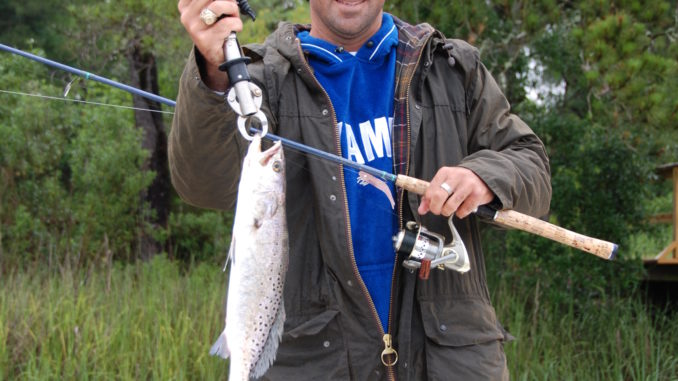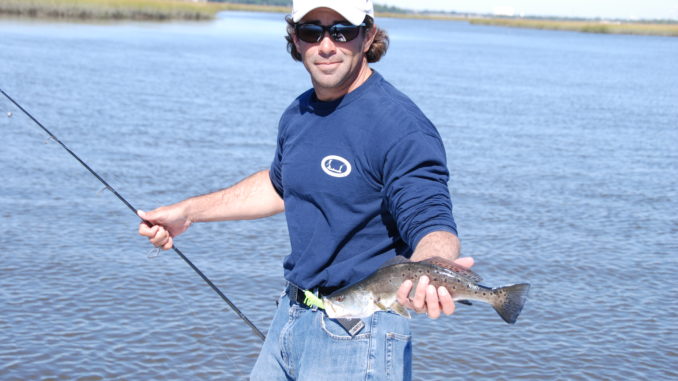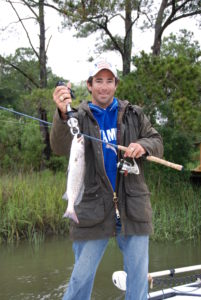
Shrimp and speckled trout in South Carolina waters took a hard lick from cold weather last winter, but both are recovering nicely and should be around for a good fall fishing season.
Before 2018, anglers had become so accustomed to mild winters along the South Carolina coast and the huge bonanza of speckled trout the good weather allowed, it was almost taken for granted. That entitlement changed almost overnight when a harsh winter storm arrived on Jan. 3 followed by nearly a week of below-freezing temperatures. The net effect was a marsh nearly frozen solid, followed by dire predictions of fish kills in the fragile estuaries of both Carolinas.
In the aftermath of the storm, through the spring and summer, Dr. Joey Ballenger, head of the S.C. Department of Natural Resources’ inshore fisheries section, and his teams began surveying and cranked up trammel net studies to determine the exact extent of the damage. By March, fears were somewhat allayed as lower than average but still acceptable numbers of trout were showing up. Fortunately, the trend got stronger as the April/May breeding season arrived.
“Given the severity of the winter, we were pleasantly surprised with the apparent state of the spotted seatrout resource based on the March catches,” Ballenger said. “It doesn’t seem to be as significant an event as we observed in 2000-2001 and 2010-2011, but because the picture’s still incomplete, we’re still exercising caution.”
Based on these hopes, SCDNR asked coastal anglers to voluntarily release all trout caught until the end of September. Trout are prolific spawners, with mature females having demonstrated spawning activity two to three times a week through the summer.

“We’re still seeing a wide range of spotted seatrout sizes,” said Ballenger. “Our biggest fear was that the larger, adult-female population was severely impacted, but it appears there were enough females left to provide an adequate spawn this year.”
Ballenger said the complete picture will not be finished until South Carolinas puts one or more winters in the rear-view mirror.
“What we don’t want to see is another harsh winter-kill back-to-back with this one,” he said. “It has happened before and the net effect is it pushes the recovery back another year until things level out.”
Along with speckled trout, the winter-kill took pretty good measure of the winter shrimp that overwintered in South Carolina waters. That delayed the opening of the commercial shrimping season a month, until June 19, to allow shrimp to spawn.
Ballenger said trout depend on shrimp as forage but said they eat a variety of aquatic species, including a mix of crustaceans and finfish.
“The trout are going to eat what’s available,” he said. “There’s not a high correlation between trout numbers and shrimp numbers, but the white shrimp that have spawned will move back into the marsh and be available, and there’s been a mix of brown shrimp as well.”

Guide John Ward of Affinity Charters in Charleston admitted 2018 has been a less-than-desirable weather year, first with the harsh cold and then a lot of fronts and winds through the summer, followed by seemingly non-stop rainfall that has made water conditions murky and made trout tough to catch, regardless of the available population.
“The trout fishing has been good on the good-water days,” he said. “I’m catching trout from 10 inches all the way up to 3 or 4 pounds.”
Ward (843-693-2460) said it’s been hard to tell if trout fishing has returned to normal because “normal” and “average” are hard to measure a couple of substantial winter fish kills in the last 20 years, followed by really mild winters in the last five or six. He said South Carolina’s trout fishery always seems to be on either a boom or bust cycle.
As a guide, Ward finds it easier to target trout with live shrimp for his clients. He said the trout in the Kiawah Island area where he does the majority of his fishing have moved to brown shrimp after the white shrimp were hard hit during the winter.
“Delaying the opening of the commercial shrimping season helped a lot,” he said. “That gave the white shrimp a chance to bounce back. Likewise, I think most of the sportsmen heeded the voluntary release of trout this year, so they’re rebounding as well.”
This fall, Ward believes the local trout population will react as it has in most recent years. As trout are mostly sight-feeders, he’s going to look for the cleanest, clearest water he can find.
“I’m still going to key in on points and rip lines, anywhere there’s a seam in the water that the fish can dart out and catch that shrimp or other food being swept by the current,” he said. “The best way to get your bait in the right areas is usually to use a popping cork with a leader anywhere from 18 inches to 3 feet.”
Ward prefers an incoming tide because of the cleaner water it brings He also prefers the water to be on the higher end of the tide cycle so there’s water moving over the tops of oysters and sandbars to create more and better rips to fish.
“In the early morning, first thing, I might be throwing a topwater bait over those rips,” he said, “but once the suns gets up, it’s back to the cork and working the bait around the rip and popping that cork hard to get their attention.”
Despite his preference for high-water trout fishing, he’s also got a few tricks up his sleeve when fishing during low tide. He will move into a bend in a creek channel and concentrate his efforts on the outside bend where the water is deeper. When he’s looking for the ideal low water trout spot, he likes to find 8 to 10 feet of water in the bend with surrounding water around 3 to 4 feet deep. He warns that trout in these conditions can be spooky and urges anglers not to rush into these areas.
“You kind of have to feel your way through, because most of the time, that low water is not going to be clear like the incoming water,” Ward said. “I like to fish a jig on a ¼-ounce head paired with a 3- to 4-inch soft plastic or throw a weighted D.O.A. shrimp and work it along that drop off in the channel bend. It may not be the best way to catch a lot of trout, but it’s a good way to catch bigger sized fish.”


Be the first to comment